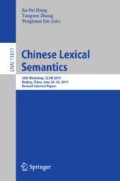Abstract
This paper mainly analyzes the semantics of three types of “hai-NP-ne” construction with NP quoted from context, formalizes their semantics with the scale structure, and compares similarities and differences among these three types of construction semantics. It is found that all these three types of “hai-NP-ne” are at the lower point of entailing scales. Meanwhile, three different types of entailing scales, including likelihood scale, felicity scale, and truth value scale, are activated by the various types of verbs that are omitted in the “hai-NP-ne” construction. As a result, various meanings are derived.
Access this chapter
Tax calculation will be finalised at checkout
Purchases are for personal use only
References
Zong, Sh.-Y.: Analysis of “Hai+NP+Ne” and “Bi+N+Hai+N”. J. Zhangjiakou Teach. Coll. (Soc. Sci.) 2, 23–27 (1995). (in Chinese)
Zong, Sh.-Y.: The construction “Hai+X+ne” in three conceptual domains: acting, knowing, and uttering. Lang. Teach. Linguist. Stud. 4, 94–103 (2016). (in Chinese)
Ding, L.: Comparison of two inference patterns “Hai+NP+ne” (S1) and “Dao di shi+NP+a” (S2) in two layers of thinking. J. Hanzhong Teach. Coll. (Soc. Sci.) 20(1), 26–30 (2002). (in Chinese)
Ding, L.: Other perspectives on the Chinese sentence structure “hai+NP+ne”. J. Shaanxi Univ. Technol. (Soc. Sci.) 25(3), 46–50 (2007). (in Chinese)
Yang, Y.-L.: On the construction of “Hai+NP+ne”. Contemp. Rhetoric 6, 48–50 (2004). (in Chinese)
Zheng, J.-M.: On the construction “Hai+NP+Ne”. Lang. Teach. Linguist. Stud. 2, 9–15 (2009). (in Chinese)
Hu, F.: An exploration on the sentence pattern of “Hai+NP+Ne”. J. Changchun Normal Univ. (Humanit. Soc. Sci.) 30(6), 91–95 (2011). (in Chinese)
Wang, T.-Y.: The semantic analysis model of pair construction “A, hai B ne” based on “(De/Re)-Categorization+”. Foreign Lang. Teach. 6, 16–21 (2015). (in Chinese)
Wang, Ch.-W.: The negation focus, pragmatic function and solidification motivation of quotative responsive construction “Hai+X+(Ne)”. J. Xinjiang Univ. (Philos. Humanit. Soc. Sci.) 45(1), 128–134 (2017). (in Chinese)
Shen, J.-X.: Two constructions with Hai in Mandarin Chinese. Stud. Chin. Lang. 6, 483–493 (2001). (in Chinese)
Fauconnier, G.: Pragmatic scales and logical structure. Linguist. Inq. 6(3), 353–375 (1975)
Guo, R.: Entailment and negation. Chin. Teach. World 2, 5–19 (2006). (in Chinese)
Fillmore, C.J., Kay, P., O’Connor, M.C.: Regularity and idiomaticity in grammatical constructions: the case of let alone. Language 64(3), 501–538 (1988)
Kennedy, C., McNally, L.: Scale structure, degree modification, and the semantics of gradable predicates. Language 81(2), 345–381 (2005)
Luo, Q.-P.: Gradability, scale structure and classification of simple adjectives in Chinese. Chin. Lang. Learn. 1, 27–38 (2018). (in Chinese)
Luo, Q.-P.: Gradable nouns and the degree interpretations of “Da+NP” constructions. Chin. Lang. Learn. 3, 43–52 (2016). (in Chinese)
Gao, Z.-X.: The basic meaning of adverb “Hai”. Chin. Teach. World 2, 28–34 (2002). (in Chinese)
Deng, Ch.-L: A semantic-pragmatic interface study of adverb Hai. Chin. Teach. World 32(4), 475–482 (2018). (in Chinese)
Acknowledgments
I would like to express my sincere gratitude to Professor Zhan Weidong, Dr. Huang Sisi, Dr. Kou Xin, Ke Lizhen for their helpful advice and insightful comments. This research is supported by the major project of Humanities & Social Science Fund of Ministry of Education of China (Project No. 15JJD740002).
Author information
Authors and Affiliations
Corresponding author
Editor information
Editors and Affiliations
Rights and permissions
Copyright information
© 2020 Springer Nature Switzerland AG
About this paper
Cite this paper
Cao, X. (2020). The Semantic Analysis and Representation of “Hai-NP-Ne” Construction with NP Quoted from Context. In: Hong, JF., Zhang, Y., Liu, P. (eds) Chinese Lexical Semantics. CLSW 2019. Lecture Notes in Computer Science(), vol 11831. Springer, Cham. https://doi.org/10.1007/978-3-030-38189-9_5
Download citation
DOI: https://doi.org/10.1007/978-3-030-38189-9_5
Published:
Publisher Name: Springer, Cham
Print ISBN: 978-3-030-38188-2
Online ISBN: 978-3-030-38189-9
eBook Packages: Computer ScienceComputer Science (R0)

